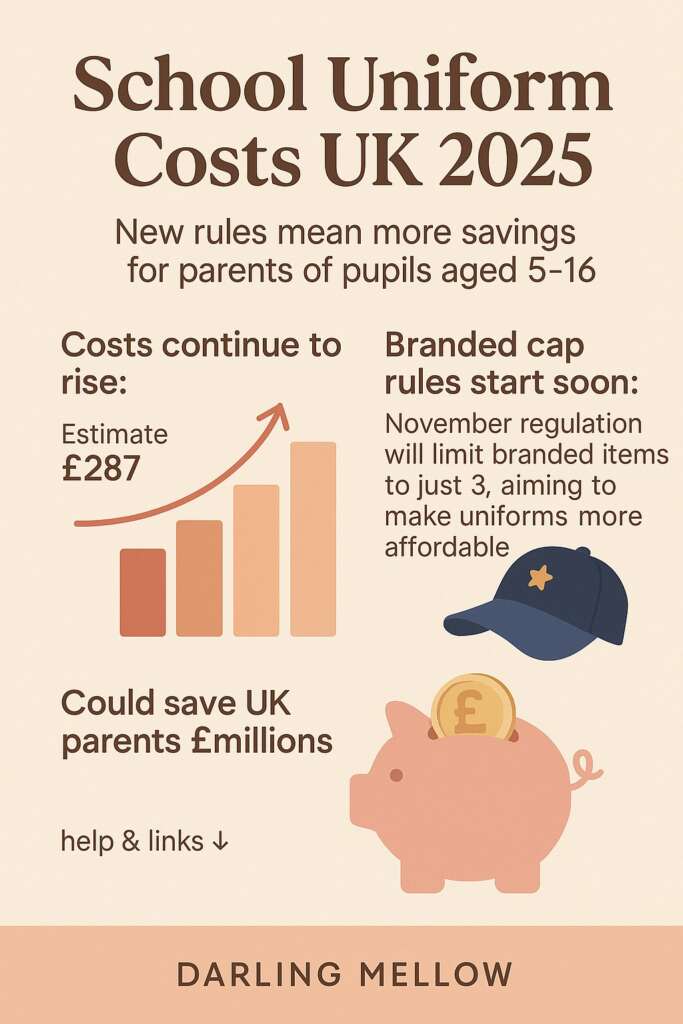School Uniform Costs in 2025: What the New Branded Item Cap Means for Parents
Families across the UK are set to save millions — but how much, and when? Here’s everything you need to know about the school uniform changes, council grants, and how to cut costs right now.
The Rising Cost of School Uniforms
Parents are spending an average of £343 a year on primary uniforms and £442 for secondary, according to the latest Parentkind survey. That figure doesn’t include extras like PE kits or shoes, and costs are rising faster than wages for many families.
Almost half (46%) of parents admitted skipping meals or heating to cover school costs, while nearly 30% have resorted to buy-now-pay-later schemes for uniforms. The crisis is particularly acute for larger families where multiple sets of branded items are compulsory.
The Branded Item Cap Explained
The Department for Education has confirmed that by September 2026, schools in England must restrict branded uniform items to a maximum of three (plus a tie for secondary schools). Branded blazers, jumpers, and skirts will no longer be mandatory in bulk — saving families around £50 per child per year.
Schools are being urged to adopt the cap early, rather than waiting for the deadline. If they do, the government estimates families could collectively save £73 million annually.
Why Girls Still Pay More
New data from The Times highlights a gender cost gap: girls’ uniforms average £289, compared to £266 for boys. At primary level, girls’ kits cost £246 vs. £217. Parents say this comes down to schools mandating specific branded skirts or cardigans for girls, which are often pricier than boys’ trousers or jumpers.
Campaigners argue schools must review gender-based rules and allow affordable alternatives to prevent parents paying a “pink tax” on education.
Uniform Grants: What’s Available?
Uniform support is a postcode lottery. Some councils still offer grants, while others have axed them completely. For example:
- Wales: Up to £200 per eligible child (one of the most generous in the UK).
- Scotland: Minimum £120 grant, set nationally.
- England: Depends entirely on your local council. Some areas offer £50–£100, others offer nothing.
The gov.uk school uniform page links directly to each council’s application portal.
Real-Life Solutions: Swap Shops & Support
In Darlington, a volunteer-led “school swap shop” run by Darlington Cares has already helped thousands of families by recycling good quality items. Across the UK, PTAs and community groups are launching similar schemes to reduce waste and cut costs.
Parents are also encouraged to ask schools to set up “second-hand rails” at parents’ evenings or induction days.
Practical Tips to Save Right Now
- Challenge extra branding: Email your school to ask if plain supermarket alternatives are allowed.
- Buy bigger: Go one size up in September to stretch through growth spurts.
- Second-hand first: Check Facebook Marketplace, local swap shops, and PTA stalls before buying new.
- Gender neutral = cheaper: Ask schools to allow trousers/skirts interchangeably to cut disparity costs.
- Label everything: Lost property is the fastest way to waste £££ on replacement kit.
Key Takeaway
The branded cap is a win for families — but only if schools act now rather than waiting until 2026. Until then, the burden falls on parents to push for cheaper options, apply for grants, and lean on community swap networks.


